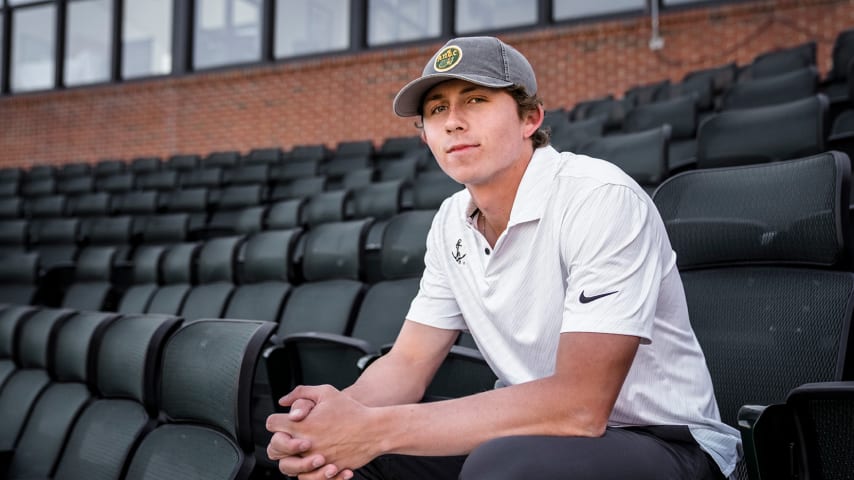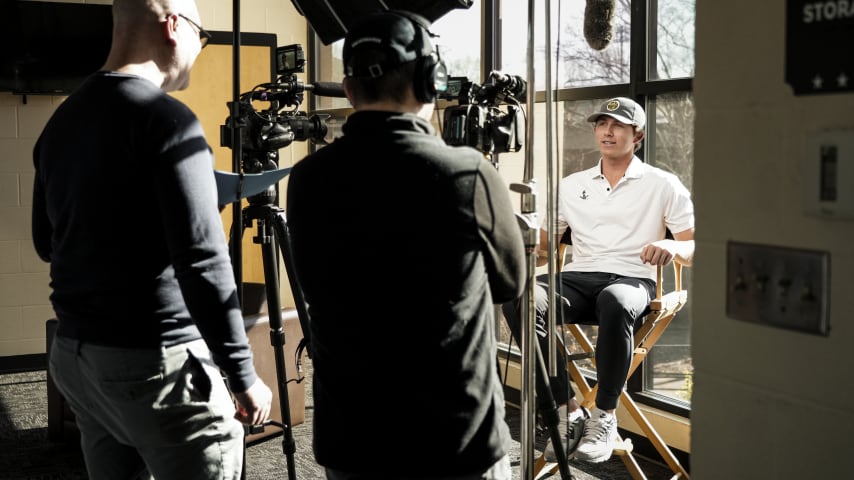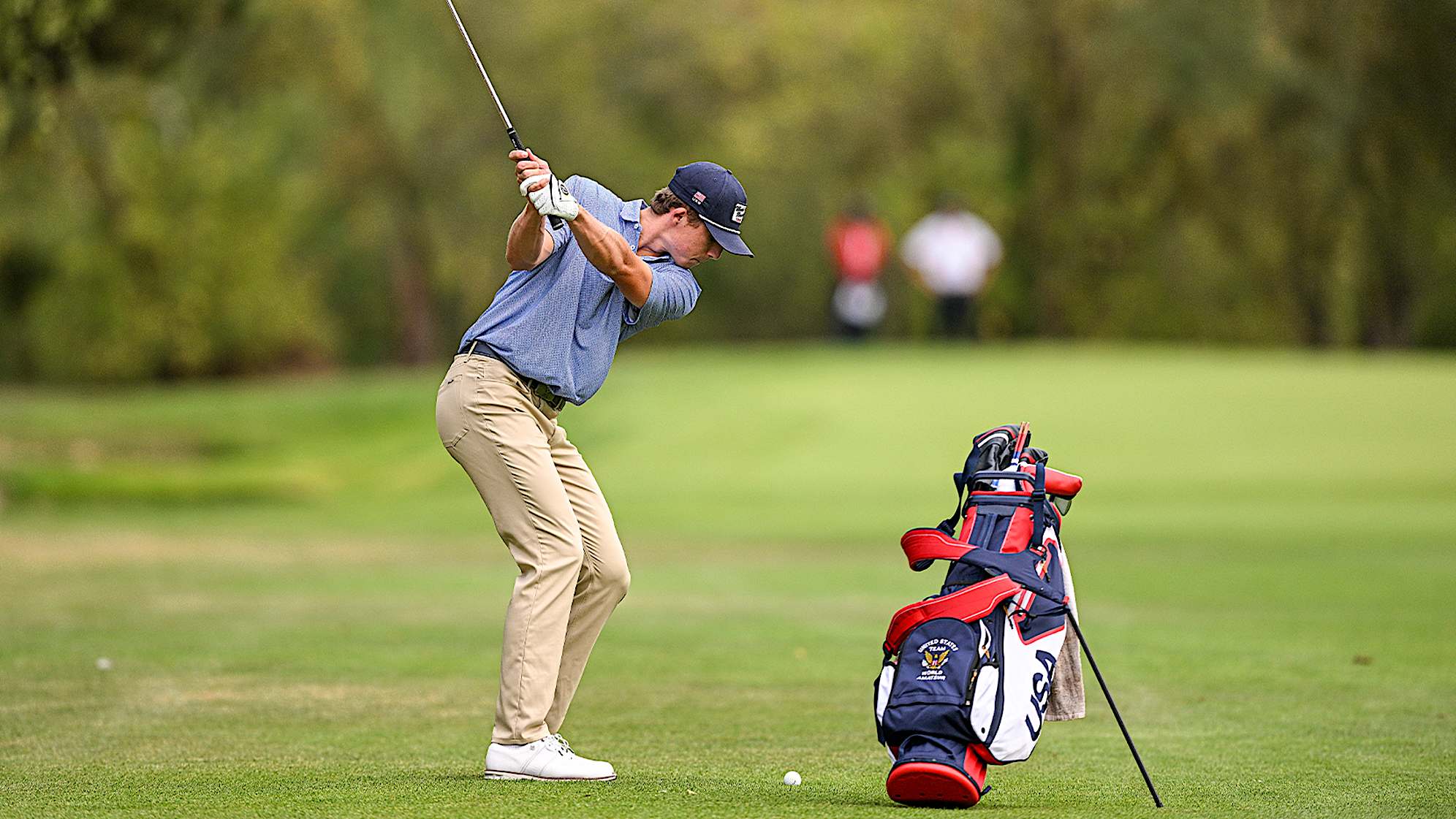Gordon Sargent is ready for Masters spotlight
9 Min Read

Written by Sean Martin
Vanderbilt sophomore is first amateur in two decades to receive special exemption to Augusta National
PONTE VEDRA BEACH, Fla. – The sky was still soft shades of blue and orange as the sun rose on this winter morning on north Florida’s Atlantic Coast. A black SUV drove down a long driveway, stopping under an overhang just a few feet from the front door of its destination. As the passengers stepped out of their clandestine transport and into the cool dawn air, multiple cameras descended on the car.
The scene looked like an unsuccessful attempt by an actor or foreign dignitary to make a surreptitious arrival, thwarted by prying paparazzi. The vehicle actually carried the hottest commodity in college golf, Vanderbilt sophomore Gordon Sargent, though. His world had changed dramatically when Augusta National unexpectedly stamped its seal of approval upon his resume, and the cameras were there to document his new reality.

Gordon Sargent Photoshoot PGA 2023
They trailed him to the putting green and then the practice tee as he warmed up for this year’s John Hayt Invitational at Sawgrass Country Club. A player from an opposing school tried to sneak some shots of the scene, holding his phone chest-high and staring down at the screen to ensure he was capturing the two cameras trained on Sargent and microphone dangling overhead. This is not typical at a college golf tournament.
But this is not a typical college golfer. And the attention has only increased after he received his surprise invitation to the world’s most famous golf tournament. The calendar had just changed to 2023 when he received the phone call that changed everything.
“I didn’t recognize the number but it said ‘Augusta National’ under the phone number, so I was like, ‘I have to answer this,’” said Sargent, 19. The rest of the conversation was a blur as he tried to determine if he was the victim of a vicious prank.
The news was made official a few days later when Augusta National announced that Sargent, the reigning NCAA champion, would be the first amateur in more than two decades to receive a special exemption to the Masters.
Augusta National Golf Club isn’t known for making exceptions to its rules. The Masters field, the smallest of any of the major championships, is determined by detailed criteria. The tournament reserves the right to make special invitations, but there’s rarely more than one doled out per year and they go almost exclusively to international pros whose inclusion increases the global footprint of the tournament. The player invited alongside Sargent was Japanese pro Kazuki Higa. The last amateur to receive a special exemption, Aaron Baddeley in 2000, hailed from Australia and was invited to the Masters after winning his national open over a field that included multiple top-50 players in the world.
That’s why Sargent’s selection carried such weight. One of the most powerful organizations in the game made an almost unprecedented move to include him in its tournament.
Approximately six amateurs compete in the Masters each year, and their invitations are tied to victories in tournaments conducted by the game’s governing bodies. That’s why players like Scottie Scheffler, Rory McIlroy, Jon Rahm, Justin Thomas and Jordan Spieth had to wait until they turned pro to make their Masters debuts. No matter how promising a prospect, an amateur isn’t driving down Magnolia Lane without winning the right tournament.
Until now.
So, why Sargent? It starts with skill, of course.
He is currently No. 1 in the World Amateur Golf Ranking and the two main collegiate rankings. The worst finish in his past 15 collegiate starts is T7, including four victories. His scoring average in 22 rounds this season is 68.0. His lowest score is 62. His highest? Seventy-two. He was medalist at the East Lake Cup in October and won the Hayt Invitational in February by seven shots over North Florida’s Nick Gabrelcik, who weeks later made the cut at the PGA TOUR’s Valspar Championship. One of Golf Channel’s college golf experts, Brentley Romine, says Sargent is the top collegiate player since Rahm. Longtime observers put him on their short list of best amateurs they’ve ever seen. One said a top-20 finish at Augusta National is not unfathomable. Sargent’s incredible length – he would challenge for the highest ball speed on TOUR despite being a relatively skinny 6 feet tall and weighing 175 pounds -- and deft touch represent a perfect skill set for the Masters.
“We all know he has a ton of speed,” said Stewart Hagestad, low amateur at the 2017 Masters and member of the last three U.S. Walker Cup teams, “but what’s really impressive is his ability to take speed off and hit touch and feel shots.”
Owning a national championship, especially a historic event conducted by an established governing body, probably helped Sargent’s case because it kept his inclusion in the Masters in line with the other amateurs. He was the first freshman in 16 years to win the NCAA Championship. Hailing from Birmingham, Alabama, and starring at an SEC school couldn’t have hurt his case with a club located in Georgia, either.
“It shows that they think you can compete with the best in the world,” Sargent said of the invitation, “and I am … looking forward to testing my game at that level.”
Questions about pro golf will always swirl around a player at his level, but Sargent swears he is in no rush to leave college golf. There’s a good chance he’ll have a PGA TOUR card waiting for him when he does. The recently announced PGA TOUR University Accelerated program awards points based on certain achievements, and players who earn 20 before the end of their junior year earn a PGA TOUR card. Since 2010, only three players would have reached the necessary threshold: Patrick Cantlay (2012), Thomas (2013) and Patrick Rodgers (2014).
Sargent already has 12 points and will earn one more for competing in the Masters. He’ll earn an additional point if he can make the cut and two more points if he finishes in the top 20. Three points apiece are awarded for winning each of college golf’s major player of the year awards – the Haskins, Jack Nicklaus and Ben Hogan awards – meaning Sargent could surpass 20 points by season’s end. His likely appearance in the Palmer Cup (1 point) and Walker Cup (2) also could help him reach that benchmark. Players who do earn a TOUR card via PGA TOUR University Accelerated can defer using their status to any time of their choosing.
For those in his home state, Sargent has been a standout since he was 9 years old. That’s when Jay Seawell, the longtime men’s golf coach at the University of Alabama, received a call from Gordon’s mother, asking if her son could attend the school’s summer golf camp. The minimum age is 10, but she ensured Seawell that her son had the attention span for the all-day instruction.
Seawell still remembers the short-game clinic that young Gordon showed up to with his cut-down Vokey wedge. The Alabama coach prides himself on his prowess around the greens and was showing the kids some chipping tips. Gordon stepped up and picked a shot cleanly off a tight lie, his ball bouncing twice before stopping abruptly next to the hole.
“I went, ‘Do you want to teach camp?’” Seawell said with a laugh. “That’s my first run-in with Gordon Sargent.”
Sargent went on to win the Alabama Junior by six in 2019, then back-to-back Alabama State Amateurs in 2020 and 2021 by five and three shots, respectively. He announced himself to a larger audience with a single swing in a stressful situation last year. It came on the first hole of a four-man playoff for the NCAA title.
The 18th hole at Grayhawk Golf Club in Scottsdale, Arizona, is protected by a bunker on the left and water on the right. Sargent swung with impunity, blasting a tee shot that landed in the fairway before trickling into the second cut. It left him just 140 yards into the 520-yard hole.
“It sent a message to everybody on that tee box that, ‘I’m about to go take this thing,’” Limbaugh told Vanderbilt’s website. “The second he hit that drive, I had about 25 text messages from former players just saying ‘OMG’ or going crazy about the ball speed.”
Sargent hit his approach shot 5 feet from the hole location cut close to the water and made the birdie putt to win the national championship. It was an emphatic statement from a player not known for emotional displays.
Sargent’s caddie for the Masters, William Kane, also carried Webb Simpson’s bag on TOUR from 2008-10. Kane said the driving display he saw from Sargent in the second round of last year’s U.S. Amateur was the best he’s witnessed. That includes rounds alongside Rory McIlroy and Dustin Johnson.
After shooting a 74 that put him in danger of missing the cut, Sargent shot a 65 – on a course where the field averaged 74.8 for the day – to finish one shot outside of the medalist position. Sargent hit 13 of 14 fairways and averaged 360 off the tee, according to Kane. Four times he was hitting sand wedge from the fairway into a hole longer than 500 yards.
Sargent’s frame belies his incredible swing speed. He stood about 5-foot-6 until he was 15. Late to hit his growth spurt, he said he learned to maximize his swing speed as he tried to keep up with larger peers. Kane calls it “restrained power.”
“He’s not always lashing at it,” said Kane, now a staff minister with College Golf Fellowship. “It’s like power under control.”
Seawell said Sargent “plays athletically with sound fundamentals, but he is not an analytical golf swing guy.”
“I think that’s why he doesn’t have many bad weeks,” Seawell added. “I think the guys who learn to compete over swinging the golf club will always last longer.”
Sargent’s college coaches praise his focus and organization, saying they are two characteristics that set him apart from his peers. Vanderbilt’s associate head coach, Gator Todd, said Sargent is one of the most organized 19-year-olds he’s seen. “He always has a plan,” Todd said.
Said Limbaugh, “He’s very locked in on how he prepares himself and trains day-to-day. For such a young person, he has a lot of awareness and conviction in how he works at his game. … He just kind of has a consistent demeanor day-to-day.”
In the weeks leading to his first major championship, Kane said Sargent has done a good job of “being where his feet are.” Seawell also coached Thomas, the two-time major winner, in college and says the common trait between the two is their knack for competition. Seawell says that is as much of a skill set as accurate iron play and precise putting.
“People all say, ‘I’m a competitive person,’ but do you know how to handle it?” said Seawell. “No matter what is going on around you, you’re playing to win. The last four to six weeks, everyone is talking about the Masters, and you haven’t seen anything in his college tournaments that shows it’s affecting his golf.”
Now, after all of the waiting, Gordon Sargent’s moment has arrived.








